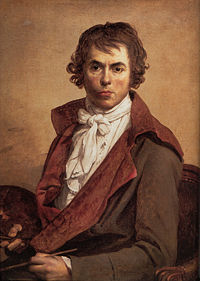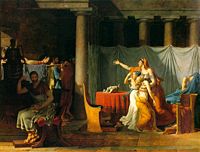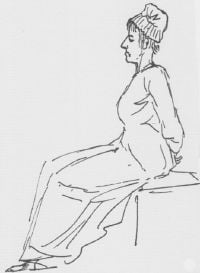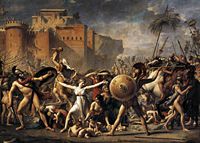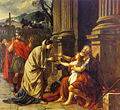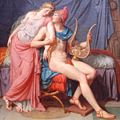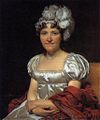Jacques-Louis David
Jacques-Louis David (August 30, 1748 â December 29, 1825) was a highly influential French painter in the Neoclassical style. In the 1780s his cerebral brand of historical painting marked a change in taste away from Rococo frivolity towards a classical austerity and severity, chiming with the moral climate of the final years of the ancien rĂ©gime.
David became an active supporter of the French Revolution and friend of Maximilien Robespierre, and was effectively a dictator of the arts under the French Republic. The Death of Marat, perhaps David's most famous painting, has been called the PietĂ of the revolution. It is not an accident that this work is described in religious terms, as the Revolution increasingly sought to replace the iconography of the Catholic Church with that of reason as an abstract idea that Robespierre attempted to have embodied in the ill-fated "Goddess of Reason."
Imprisoned after Robespierre's fall from power, he aligned himself with yet another political regime upon his release, that of Napoleon Bonaparte. It was at this time that he developed his 'Empire style,â notable for its use of warm Venetian colors. David had a huge number of pupils, making him the strongest influence in French art of the nineteenth century, especially academic Paris Salon painting.
Early life
David was born into a prosperous family in Paris on August 30, 1748. When he was nine, his father was killed in a duel, and his mother left him with his prosperous architect uncles. They saw to it that he received an excellent education at the CollĂšge des Quatre-Nations, but he was never a good student; he had a tumor that impeded his speech, and he was always too busy drawing. He covered his notebooks with drawings, and he once said, "I was always hiding behind the instructorâs chair, drawing for the duration of the class." Soon, he desired to be a painter, but his uncles and mother wanted him to be an architect. He soon overcame the opposition, and went to learn from François Boucher, the leading painter of the time, who was also a distant relative. Boucher was a Rococo painter, which was falling out of style and becoming more classical. Boucher decided that instead of taking over Davidâs tutelage, he would send David to his friend Joseph-Marie Vien, a mediocre painter, but one that embraced the classical reaction to Rococo. There, David attended the AcadĂ©mie de peinture et de sculpture (Royal Academy), based in what is now the Louvre.
David attempted to win the Prix de Rome, an art scholarship to the French Academy in Rome four times. Once, he lost, according to legend, because he had not consulted Vien, one of the judges. Another time, he lost because a few other students had been competing for years, and Vien felt David's education could wait for these other mediocre painters. In protest, he attempted to starve himself to death. Finally, in 1774, David won the Prix de Rome. Normally, he would have had to attend another school before attending the Academy in Rome, but Vien's influence kept him out of it. He went to Italy with Vien in 1775, as Vien had been appointed director of the French Academy at Rome. While in Italy, David observed the Italian masterpieces and the ruins of ancient Rome. David filled sketchbooks with material that he would derive from for the rest of his life. While in Rome, he studied great masters, and came to favor above all others Raphael. In 1779, David was able to see the ruins of Pompeii, and was filled with wonder. After this, he sought to revolutionize the art world with the "eternal" concepts of classicism.
Early work
David's fellow students at the academy found him difficult to get along with, but they recognized his genius. David was allowed to stay at the French Academy in Rome for an extra year, but after five years in Rome, he returned to Paris. There, he found people ready to use their influence for him, and he was made a member of the Royal Academy. He sent two paintings to the Royal Academy, and both were included in the Paris Salon of 1781, a high honor. His famous contemporary painters praised him, but the administration of the Royal Academy was very hostile to this young upstart. After the Salon, the King granted David lodging in the Louvre, an ancient and much desired privilege of great artists. When the contractor of the King's buildings, M. Pecol, was arranging with David, he asked the artist to marry his daughter, Marguerite Charlotte. This marriage brought him money and eventually four children. David had his own pupils (between 40 and 50) and was commissioned by the government to paint "Horace defended by his Father," but Jacques soon decided, "Only in Rome can I paint Romans." His father-in-law provided the money he needed for the trip, and David headed for Rome with his wife and three of his students, one of whom, Jean-Germain Drouais, was the Prix de Rome winner of that year.
In Rome, David painted his famous Oath of the Horatii. The themes and motifs would carry on into his later works Oath of the Tennis Court and Distribution of Eagles. While Oath of the Horatii and Oath of the Tennis Court stress the importance of masculine self-sacrifice for one's country and patriotism, the Distribution of Eagles would ask for self-sacrifice for one's Emperor (Napoleon) and the importance of battlefield glory.
In 1787, David did not become the director of the French Academy in Rome, a position he wanted dearly. The count in charge of the appointments said David was too young, but said he would support Jacques in six to 12 years. This situation would be one of many that would cause him to lash out at the Academy in years to come.
For the salon of 1787, David exhibited his famous Death of Socrates. Critics compared the Socrates with Michelangeloâs Sistine Chapel Ceiling and Raphael's Stanze, and one, after ten visits to the Salon, described it as "in every sense perfect." Denis Diderot said it looked like he copied it from some ancient bas-relief. The painting was very much in tune with the political climate at the time. For this painting, David was not honored by a royal "works of encouragement."
For his next painting, David painted The Lictors Bring to Brutus the Bodies of His Sons. The work had tremendous appeal for the time. Before the opening of the Salon, the French Revolution had begun. The National Assembly had been established, and the Bastille had fallen. The royal court did not want propaganda agitating the people, so all paintings had to be checked before being hung. Some portraits of famous people were banned, like the portrait of a chemist who happened to be a member of an ill-favored party. When the newspapers reported that the government had not allowed the showing of The Lictors Bring to Brutus the Bodies of His Sons, the people were outraged, and the royals gave in. The painting was hung in the exhibition, protected by art students. The painting depicts Lucius Junius Brutus, the Roman leader, grieving for his sons. Brutus's sons had attempted to overthrow the government and restore the monarchy, so the father ordered their death to maintain the republic. Thus, Brutus was the heroic defender of the republic, at the cost of his own family. On the right, the mother holds her two daughters, and the grandmother is seen on the far right, in anguish. Brutus sits on the left, alone, brooding, but knowing what he did was best for his country. The whole painting was a Republican symbol, and obviously had immense meaning during these times in France.
The Revolution
In the beginning, David was a supporter of the Revolution, a friend of Maximilien Robespierre and a Jacobin. While others were leaving the country for new and greater opportunities, David stayed to help destroy the old order. This fact is puzzling to some, as there were many more opportunities for him under the king than the new order. Some people suggest David's love for the classical made him embrace everything about that period, including a republican government. Others believed that they found the key to the artist's revolutionary career in his personality. Undoubtedly, David's artistic sensibility, mercurial temperament, volatile emotions, ardent enthusiasm, and fierce independence might have been expected to help turn him against the established order but they did not fully explain his devotion to the republican regime. Nor did the vague statements of those who insisted upon his "powerful ambitionâŠand unusual energy of willâ actually account for his revolutionary connections. Those who knew him maintained that "generous ardor," high-minded idealism and well meaning, though sometimes fanatical, enthusiasm rather than selfishness and jealousy, motivated his activities during this period."
Soon, David turned his critical sights on Royal Academy. This attack was probably caused primarily by hypocrisy of the organization and their personal opposition against his work, as seen in previous episodes in Davidâs life. The Royal Academy was full of royalists, and Davidâs attempt to reform it did not go over well with the members. However, the deck was stacked against this symbol of the old republic, and the National Assembly ordered it to make changes to conform to the new constitution.
David then began work on something that would later hound him: propaganda for the new republic. Davidâs painting of Brutus was shown during the play Brutus, by the famous Frenchman, Voltaire. The people responded in an uproar of approval. On June 20, 1790, the anniversary of the first act of defiance against the king, the oath of the tennis court was celebrated. Wanting to commemorate the event in a painting, the Jacobins, revolutionaries that had taken to meeting in the Jacobin Monastery, decided that they would choose the painter whose "genius anticipated the revolution." David accepted, and began work on a mammoth canvas. The picture was never fully completed, because of its immense size (35 feet by 36 feet) and because people that needed to sit for it disappeared in the Reign of Terror, but several finished drawings exist.
When Voltaire died in 1778, the church denied him a church burial and his body was interred near a monastery. A year later, Voltaireâs old friends began a campaign to have his body buried in the PanthĂ©on, as church property had been confiscated by the French government. David was appointed to head the organizing committee for the ceremony, a parade through the streets of Paris to the PanthĂ©on. Despite rain and opposition from conservatives based on the amount of money that was being spent, the procession went ahead. Up to 100,000 people watched the "Father of the Revolution" carried to his resting place. This was the first of many large festivals organized by David for the republic. He went on to organize festivals for martyrs that died fighting royalists. These funerals echoed the religious festivals of the pagan Greeks and Romans and are seen by many as Saturnalian.
In 1791, the king attempted to flee the country, and the emperor of Austria announced his intention to restore the monarchy. In reaction, the people arrested the king. The French people finally destroyed the monarchy in 1792. When the new National Convention held its first meeting, David was sitting with his friends Jean-Paul Marat and Robespierre. In the convention, David soon earned a nickname "ferocious terrorist." Soon, Robespierreâs agents discovered a secret vault of the kingâs that proved he was trying to overthrow the government, and demanded his execution. The National Convention held the trial of Louis XVI and David voted for the death of the king, which caused his wifeâa royalistâto divorce him.
When Louis XVI was executed on January 21, 1793, another man died as wellâLouis Michel le Peletier, de Saint-Fargeau. Le Peletier was killed by a royal bodyguard for voting for the death of the king. David was called upon once again to organize a funeral, and David painted Le Peletier Assassinated. It depicts a bloody sword hanging from a thread, thrust through a note that states, "I vote the death of the tyrant." Le Peletierâs body is below this sword. The painting has disappeared, and is known only by a drawing, contemporary accounts, and an engraving.
Soon, David's friend Marat was assassinated by Charlotte Corday, a woman of an opposing political party, whose name can be seen in the note Marat holds in David's subsequent painting, The Death of Marat. David once again organized a spectacular funeral, and Marat was buried in the PanthĂ©on. Marat died in the bathtub, writing. David wanted to have his body submerged in the bathtub during the funeral procession, but the body had begun to putrefy. Instead, Maratâs body was periodically sprinkled with water as the people came to see his corpse, complete with gaping wound. The Death of Marat, perhaps David's most famous painting, has been called the PietĂ of the revolution. Upon presenting the painting to the convention, he said, "Citizens, the people were again calling for their friend; their desolate voice was heard: David, take up your brushes ⊠avenge Marat ⊠I heard the voice of the people. I obeyed." David had to work quickly, but the result was a simple and powerful image.
After killing the king, war broke out between the new republic and virtually every major power in Europe, and the wars went very poorly for France. The Committee of Public Safety, headed by Robespierre, came to be virtual dictator of the country, and set grain prices for Paris. The committee was severe; Marie Antoinette went to the guillotine, an event recorded in famous sketch by David. Portable guillotines killed failed generals, aristocrats, priests and perceived enemies. David organized his last festival: The festival of the Supreme Being. Robespierre had realized what a tremendous propaganda tool these festivals were, and he decided to create a new religion, mixing moral ideas with the republic, based on the ideas of Rousseau, with Robespierre as the new high priest. This process had already begun by confiscating church lands and requiring priests to take an oath to the state. The festivals, called fĂȘtes, would be the method of indoctrination. On the appointed day, 20 Prarial by the revolutionary calendar, Robespierre spoke, descended steps, and with a torch presented to him by David, incinerated a cardboard image symbolizing atheism, revealing an image of wisdom underneath. The festival hastened the "incorruptible's" downfall. Later, some see Davidâs methods as being taken up by Vladimir Lenin, Benito Mussolini, and Adolf Hitler. These massive propaganda events brought the people together. France tried to have festivals in the United States, but soon received word that "to tell the truth, these methods, excellent in France where the mass of the people take part, have here only a shabby air."
Soon, the war began to go well; French troops marched across Belgium, and the emergency that had placed the Committee of Public Safety in control was no more. Plotters seized Robespierre at the National Convention. During this seizure, David yelled to his friend "if you drink hemlock, I shall drink it with you." After all this excitement, he fell ill, and did not attend the evening session, which saved him from being guillotined along with Robespierre. David was arrested and placed in prison. There he painted his own portrait, as well as that of his jailer.
Post-Revolution
After Davidâs wife visited him in jail, he conceived the idea of telling the story of the Sabine Women. The Sabine Women Enforcing Peace by Running between the Combatants, also called The Intervention of the Sabine Women is said to have been painted to honor his wife, with the theme being love prevailing over conflict. The painting was also seen as a plea for the people to reunite after the bloodshed of the revolution. It was this work that also brought him to the attention of Napoleon.
The story for the painting is as follows:
The Romans have abducted the daughters of their neighbors, the Sabines. To avenge this abduction, the Sabines attacked Rome, although not immediatelyâsince Hersilia, the daughter of Tatius, the leader of the Sabines, had been married to Romulus, the Roman leader, and then had two children by him in the interim. Here we see Hersilia between her father and husband as she adjures the warriors on both sides not to take wives away from their husbands or mothers away from their children. The other Sabine Women join in her exhortations.
During this time, the martyrs of the revolution were taken from the Panthéon and buried in common ground, and revolutionary statues were destroyed. When he was finally released from prison, France had changed.
David released from prison largely due to his wifeâs efforts. Soon after, he wrote letters to his former wife and told her he never ceased loving her. He remarried her in 1796. Finally, wholly restored to his position, he retreated to his studio, took pupils, and retired from politics.
Napoleon
In one of history's great coincidences, David's close association with the Committee of Public Safety during the Terror resulted in his signing of the death warrant for one Alexandre de Beauharnais, a minor noble. De Beauharnais's widow, Joséphine de Beauharnais, would later be known to the world as Josephine Bonaparte, Empress of the French. It was her coronation by her husband, Napoleon I, that David depicted so memorably in the Coronation of Napoleon and Josephine, 2 December 1804.
David had been an admirer of Napoleon from their first meeting, struck by the then-General Bonaparte's classical features. Requesting a sitting from the busy and impatient general, David was able to sketch Napoleon in 1797. David recorded the conqueror of Italy's face, but the full composition of General Bonaparte holding the peace treaty with Austria remains unfinished. Napoleon had high esteem for David, and asked him to accompany him to Egypt in 1798, but David refused, claiming he was too old for adventuring and sending instead his student, Antoine-Jean Gros.
After Napoleon's successful coup in 1799, as First Consul he commissioned David to commemorate his daring crossing of the Alps. The crossing of the St. Bernard Pass had allowed the French to surprise the Austrian army and win victory at the Battle of Marengo on June 14, 1800. Although Napoleon had crossed the Alps on a mule, he requested that he be "portrayed calm upon a fiery horse." David complied with Napoleon Crossing the Saint-Bernard. After the proclamation of the empire in 1804, David became the official court painter of the regime.
One of the works David was commissioned for was The Coronation of Napoleon in Notre Dame. David was permitted to watch the event. He had plans of Notre Dame delivered and participants in the coronation came to his studio to pose individually, though never the emperor (the only time David obtained a sitting from Napoleon had been in 1797). David did manage to get a private sitting with the Empress Josephine and Napoleon's sister, Caroline Murat, through the intervention of erstwhile art patron, Marshal Joachim Murat, the emperor's brother-in-law. For his background, David had the choir of Notre Dame act as his fill-in characters. The Pope came to sit for the painting, and actually blessed David. Napoleon came to see the painter, stared at the canvas for an hour and said "David, I salute you." David had to redo several parts of the painting because of Napoleon's various whims, and for this painting David received only 24,000 Francs.
Exile

After the Bourbons returned to power, David was on the list of proscribed former revolutionaries and Bonapartists, as during the French Revolution, he had voted for the execution of Louis XVI, the older brother of the new King, Louis XVIII. Louis XVIII, however, granted David amnesty and even offered him a position as a court painter. David refused this offer, preferring instead to seek a self-imposed exile in Brussels. There, he painted Cupid and Psyche and lived out the last days of his life quietly with his wife, whom he had remarried. During this time, he largely devoted his efforts to smaller-scale paintings of mythological scenes and to portraits of Bruxellois and Napoleonic emigres, such as the Baron Gerard.
His last great work, Mars Disarmed by Venus and the Three Graces was begun in 1822 and was finished the year before his death. In December 1823, he wrote:
This is the last picture I want to paint, but I want to surpass myself in it. I will put the date of my 75 years on it and afterwards I will never again pick up my brush.
The painting was first shown in Brussels and then was sent to Paris, where David's former students flocked to see the painting. The exhibit managed to bring in 13,000 francs after operating costs, meaning there were more than ten thousand visitors, a huge number for the time.
When David was leaving the theater, he was hit by a carriage and later died of deformations to the heart in December 29, 1825. After his death, some of his portrait paintings were sold at auction in Paris, with his paintings going for very small sums. His famous painting of Marat was shown in a special secluded room so as not to outrage the public. Davidâs body was not allowed into France and was, therefore, buried in Brussels, but his heart was buried at PĂšre Lachaise, Paris.
The Death of Socrates (1787)
Portrait of Monsieur Lavoisier and his wife (1788)
Coronation of Napoleon, 1806
Leonidas at Thermopylae (1814)
ReferencesISBN links support NWE through referral fees
- CGFA. CGFA- Bio: Jacques-Louis David. Retrieved March 23, 2007.
- Chodorow, Stanley, et. al. The Mainstream of Civilization. New York: The Harcourt Press, 1994. ISBN 9780155011977.
- Dowd, David. Pageant-Master of the Republic. Lincoln: University of Nebraska Press, 1948. ISBN 9780836950052.
- Leymarie, Jean. French Painting, The 19th Century. Cleveland, 1962.
- Lindsay, Jack. Death of the Hero. London: Studio Books, 1960. ISBN 1399491423.
External links
All links retrieved December 13, 2024.
Credits
New World Encyclopedia writers and editors rewrote and completed the Wikipedia article in accordance with New World Encyclopedia standards. This article abides by terms of the Creative Commons CC-by-sa 3.0 License (CC-by-sa), which may be used and disseminated with proper attribution. Credit is due under the terms of this license that can reference both the New World Encyclopedia contributors and the selfless volunteer contributors of the Wikimedia Foundation. To cite this article click here for a list of acceptable citing formats.The history of earlier contributions by wikipedians is accessible to researchers here:
The history of this article since it was imported to New World Encyclopedia:
Note: Some restrictions may apply to use of individual images which are separately licensed.
